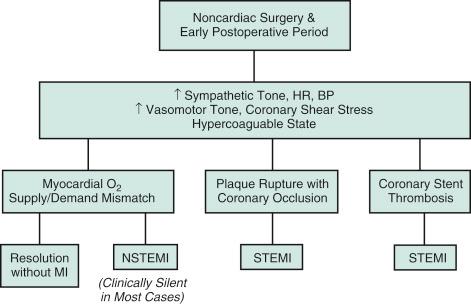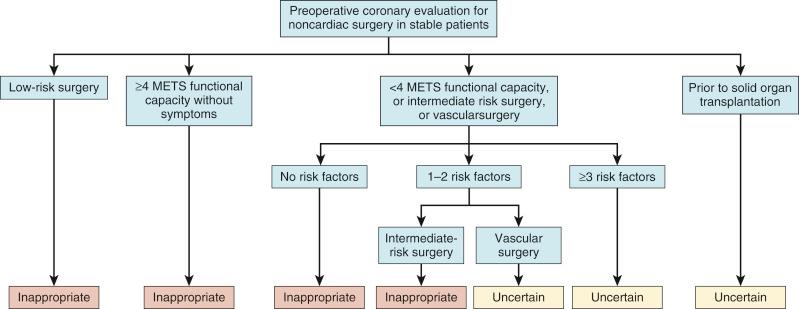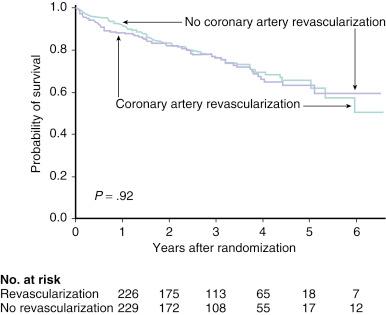Physical Address
304 North Cardinal St.
Dorchester Center, MA 02124
Perioperative myocardial infarction typically occurs in the first 48 to 72 hours following noncardiac surgery (NCS) and, even if clinically silent, is associated with substantial early and late mortality.
The initiation of β-blocker and/or aspirin therapy prior to NCS for patients not already taking these medications is associated with an increase in adverse perioperative events and is not recommended.
The indications for performing coronary angiography prior to NCS are limited to a very select subset of patients at the highest risk for adverse cardiac events, and the routine use of percutaneous coronary intervention (PCI) to “get a patient through” NCS is unproven and potentially harmful.
NCS performed within 4 to 6 weeks of stent implantation is associated with a substantial risk of stent thrombosis and major adverse cardiac events (MACEs). Surgery should be delayed if possible for 2 weeks after balloon angioplasty, 1 month after bare-metal stenting, and ideally for 3 to 6 months following drug-eluting stent placement.
When a patient with recent stent placement subsequently requires unanticipated NCS, the decision whether to continue or suspend antiplatelet therapy for surgery demands individualized assessment of the competing risks of bleeding complications and stent thrombosis. This decision should be made with multidisciplinary input from the cardiologist, surgeon, and other involved subspecialists.
When patients with prior PCI on dual antiplatelet therapy require interruption of P2Y 12 inhibitor therapy for NCS, aspirin should be continued whenever possible and P2Y 12 inhibitor therapy should be restarted as soon as safely feasible postoperatively.
Prompt recognition and treatment of postoperative cardiac complications following NCS is a critical element in optimizing patient outcomes.
For patients with severe symptomatic aortic valve stenosis who require NCS, definitive therapy with surgical aortic valve replacement or transcatheter aortic valve replacement should be strongly considered prior to elective surgery, and preoperative balloon aortic valvuloplasty is a consideration if NCS is urgent.
Noncardiac surgery (NCS) is associated with a considerable risk of adverse cardiac events among individuals with coronary artery or aortic valve disease. It has been noted that if perioperative mortality were categorized as a unique entity, it would constitute the third leading cause of death in the United States, with approximately one-third of such fatal complications related to cardiac events. Using clinical prediction tools and sensitive biomarker assays including B-type natriuretic peptide (BNP), physicians have become more adept at stratifying surgical risk, yet measures to modify risk remain inadequate. Although the performance of percutaneous coronary intervention (PCI) prior to NCS to limit adverse perioperative events is generally neither advantageous nor clinically appropriate, selected patients at particularly increased risk may benefit from preoperative coronary revascularization. In addition, up to 10% of individuals who undergo coronary stenting require unanticipated NCS within the subsequent year. For these patients, decisions regarding the management of antiplatelet therapy can be complex and require careful consideration of the competing risks of perioperative stent thrombosis and bleeding. This chapter will provide a clinically oriented review of perioperative PCI including current indications for considering PCI prior to NCS, best approaches to performing angioplasty and stenting in the preoperative setting, strategies for managing antiplatelet therapy among patients with recent stent placement who require unanticipated NCS, and considerations for undertaking PCI in the early postoperative period when cardiac complications arise with NCS. In addition, principles regarding the use of transcatheter therapies for treatment of severe aortic valve disease prior to NCS will be reviewed.
As with myocardial infarction (MI) outside the context of surgery, perioperative myocardial infarction (PMI) can result either from atherosclerotic plaque rupture with thrombotic occlusion of the involved coronary artery (type 1 MI) or from a transient stress-induced mismatch of myocardial oxygen supply and demand, possibly in the setting of a fixed coronary artery stenosis or occlusion (type 2 MI). Thrombosis of a previously implanted coronary stent represents another potential mechanism for PMI and is associated with particularly high mortality rates. In the vast majority of instances, PMI does not occur during the surgical procedure but rather within the first 48 to 72 hours following surgery. This period is associated with multiple hemodynamic stresses and hematologic alterations that can predispose to plaque rupture, myocardial oxygen supply-demand mismatch, and a hypercoagulable state ( Fig. 8.1 ). The risk of MI can remain elevated for several weeks following major surgery. The reported incidence of PMI varies considerably depending on the definition of MI and the risk profile of the population under study. The majority of infarcts in the postoperative period are clinically silent and remain unrecognized unless routine troponin testing is performed. In the large Vascular Events in Noncardiac Surgery Patients Cohort Evaluation (VISION) study of 21,482 patients undergoing NCS, standardized high-sensitivity troponin T (hsTnT) testing detected the occurrence of PMI among 17.9% of participants, of whom 93.1% did not experience ischemic symptoms. In another large study, routine troponin testing after NCS was associated with a threefold greater detection rate of PMI compared with testing prompted by clinical suspicion alone.

Thirty-day mortality rates following PMI are quite high, in the range of 10%, and even small or clinically silent infarcts are associated with considerably elevated intermediate- and late-term mortality independent of other clinical factors. In a prospective study of 2018 consecutive patients undergoing NCS who were considered at increased cardiovascular risk, PMI detected by interval rise in hsTnT occurred after 16% of surgeries and was associated with a 30-day crude mortality rate of 8.9%, representing a sixfold increase compared with patients without PMI. In a study of more than 15,000 patients undergoing NCS, small elevations in troponin T (0.02 ng/mL) were associated with a fourfold increase in 30-day mortality, and higher levels (≥0.30 ng/mL) were linked to a 16-fold escalation in 30-day death. The same dose-dependent relationship holds true for the hsTnT assay, with a 30-day mortality rate approaching 30% among individuals whose postoperative levels exceeded 1000 ng/L in the VISION cohort.
Despite the frequency and adverse implications of PMI, evidence that prophylactic coronary angiography and/or revascularization can mitigate the risk of perioperative cardiac events is lacking. The American College of Cardiology (ACC)/American Heart Association (AHA) consensus guidelines assert that preoperative coronary revascularization is “appropriate for only a small subset of patients at very high risk” and should be used sparingly if at all. It should be emphasized that, for patients who require emergency NCS, evaluation for coronary disease should not delay the necessary surgical procedure. For clinically stable patients, the current appropriate use criteria (AUC) for diagnostic catheterization offer limited indications for performing coronary angiography prior to NCS ( Fig. 8.2 ). Based primarily on expert opinion, specific instances when preoperative coronary angiography should be considered include :
Noninvasive test results suggesting a high risk of adverse outcomes, such as extensive (multivessel distribution) MI, prior to high-risk surgery.
Canadian Cardiovascular Society (CCS) class III or IV angina not responsive to appropriate medical therapy.
Recent acute coronary syndrome or MI.
Moderate or severe aortic valve stenosis and anginal symptoms or heart failure.

Although multiple medications, including β-blockers, aspirin, and statins, have been evaluated as means to reduce the frequency of adverse cardiovascular events with NCS, contemporary randomized controlled trial data do not support the routine preoperative initiation of any of these therapies. The large randomized Patients Undergoing Noncardiac Surgery (POISE) trial showed that extended-release metoprolol started 2 to 4 hours before NCS was associated with a reduction of cardiovascular death, MI, or cardiac arrest at 30 days; however, this advantage was offset by significantly increased frequencies of both all-cause mortality and stroke related to undesired bradycardia and hypotension among patients treated with β-blockers. Current ACC/AHA guidelines recommend that “beta-blockers should be continued in patients undergoing surgery who are [already] receiving beta-blockers” for appropriate indications, but the routine initiation of high-dose β-blockers prior to surgery in the absence of dose titration is contraindicated (class III) for patients undergoing NCS who are not already taking β-blockers. In the POISE-2 trial, aspirin therapy started immediately prior to NCS was associated with a significant increase in major bleeding events but not with a reduction in PMI or other cardiovascular events. Consequently, current guidelines strongly recommend against the initiation or continuation of aspirin therapy to prevent perioperative events, except for patients with a recent coronary stent or those undergoing carotid endarterectomy. Likewise, despite observational data supporting statin use for reducing perioperative complications, the initiation of high-intensity statin therapy among statin-naïve patients undergoing NCS was not associated with a reduction in adverse cardiovascular events or all-cause mortality in the randomized Lowering the Risk of Operative Complications Using Atorvastatin Loading Dose (LOAD) trial.
Two randomized trials have examined the role of coronary revascularization as a means to reduce the likelihood of perioperative events among individuals with stable coronary artery disease (CAD) scheduled to undergo vascular surgery. Despite limitations including their modest size (<200 subjects in the two studies combined underwent PCI), use of older-generation stents, and documentation of investigator misconduct in one of the two studies, these trials serve as the foundation for current recommendations that are critical of routine preoperative coronary revascularization.
The Coronary Artery Revascularization Prophylaxis (CARP) trial compared the strategy of preoperative coronary revascularization with that of stand-alone medical therapy for the reduction of early and late cardiac events following major vascular surgery. The trial enrolled 510 patients scheduled for vascular surgery at one of 18 Veterans Affairs (VA) Medical Centers. Patients were eligible if angiography-proven CAD with a 70% or more stenosis in at least one major epicardial coronary artery was present, and they were randomized to either coronary revascularization followed by vascular surgery or to vascular surgery without preceding coronary revascularization. Among the group randomized to coronary revascularization, 41% of patients underwent coronary artery bypass grafting (CABG), and 59% were treated with PCI.
The majority of patients enrolled in the CARP trial were at low to intermediate rather than high risk for perioperative coronary events. The median age was 66 years, and whereas 42% had a prior MI, only 38% noted the presence of angina at the time of study entry, and less than 50% underwent a stress imaging study that documented moderate or severe ischemia prior to coronary angiography. Most patients had one- or two-vessel coronary disease with preserved left ventricular (LV) function, and those with left main stenosis of 50% or greater, a left ventricular ejection fraction (LVEF) of less than 20%, or severe aortic stenosis (AS) were excluded. The results of the CARP trial indicated that preoperative revascularization was not associated with any apparent benefit over conservative therapy. Although patients assigned to coronary revascularization had a significantly longer delay between randomization and vascular surgery (54 vs. 18 days), neither preoperative PCI nor CABG was associated with a reduction in the occurrence of adverse cardiac events or overall survival following vascular surgery at 30-day or 2.7-year follow-up ( Fig. 8.3 ).

The Dutch Echocardiographic Cardiac Risk Evaluation Applying Stress Echocardiography (DECREASE-V) pilot study was designed to evaluate the effectiveness of prophylactic coronary revascularization prior to major vascular surgery among a higher-risk group of patients than those enrolled in the CARP trial. A total of 101 patients with extensive myocardial ischemia on noninvasive stress imaging were randomized to either revascularization (65% had PCI, 35% had CABG) or no revascularization prior to vascular surgery. Within this small cohort, preoperative coronary revascularization was not associated with significant differences in the occurrence of death or MI either at 30 days or 1 year following NCS. Thus, despite their potential shortcomings, the CARP and DECREASE-V results lend support to the concept that performing prophylactic coronary revascularization in the setting of stable CAD for the purpose of “getting a patient through” NCS is rarely appropriate.
Become a Clinical Tree membership for Full access and enjoy Unlimited articles
If you are a member. Log in here